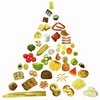 Baklava history and recipe
Baklava history and recipeBaklava
a rich, sweet pastry found in many cuisines of the Middle East, South Asia, and the Balkans. It is made of chopped nuts layered with phyllo pastry, sweetened with sugar or honey syrupThe history of baklava, like that of many other foods, is not well documented. Though it has been claimed by many peoples, the best evidence is that, despite its Arabic-seeming name, it is of Turkish origin.
Vryonis (1971) identified the ancient Greek gastris, kopte, kopton, or koptoplakous, mentioned in the Deipnosophistae, as baklava, and calls it a "Byzantine favorite." However, Perry (1994) shows that though gastris contained a filling of nuts and honey, it did not include any dough; instead, it involved a honey and ground sesame mixture similar to modern pasteli or halva .
Perry then assembles evidence to show that layered breads were created by Turks in Central Asia and argues that the "missing link" between the Central Asian folded or layered breads (which did not include nuts) and modern phyllo-based pastries like baklava is the Azerbaijani dish Baki pakhlavası. Further development would have occurred in the kitchens of the Topkapi Palace, where the Janissaries had an annual celebration called Baklava Alayı.PreparationIf layering in a baking dish, layer and butter a dozen phyllo pastry sheets, then top with a mixture of ground nuts and a little sugar (and cinnamon, for variation, if desired). Walnuts or pistachios are used most often, sometimes with a combination of almonds and pecans. After the nut mixture has been spread evenly across the phyllo, layer and butter the remaining dozen phyllo sheets. Before baking, cut baklava with a sharp knife into diamonds (traditional in Lebanese cuisine) or squares.
If rolling, butter 5 individual sheets of phyllo, then place nut mixture along 1 side of the phyllo and proceed to roll up like a tight log. Once rolled, cut the log on the diagonal into about 12 to 13 pieces. Do not cut all the way through until after the baklava is baked. For easier handling, the logs can be frozen for 10 to 15 minutes to firm them up.
Whether using the pan or rolled technique, the procedure is the same after the baklava is baked. Pour on the syrup (equal parts sugar and water boiled to a syrup consistency and then mixed with either a small amount of lemon juice and rose water (traditional in Lebanese cuisine) or with honey, cinnamon and cloves (traditional in Greek cuisine). As the hot syrup douses the baklava fresh out of the oven, it boils again and thickens by evaporation. It is then ready to cool down until ready to serve, or to refrigerate and serve later.
RecipeINGREDIENTS Filling 500 gr. walnuts,
coarsely chopped
60 gr. sugar
1 teaspoon cinnamon
Pastry
500 gr. fyllo dough,
180 gr. insalted butter melted
Syrup
230 gr. caster sugar,
300 ml water,
cinnamon sticks,
2 teasponn lemon juice,
some lemon peel,
2 teablespoon honey
METHOD
Mix all the filling ingredients in a bowl.Liberally butter the base and sides of an elongated or round baking dish. Measure the length of the fyllo against the baking dish roughly and, allowing 2 cm extra approximately for shrinkage, cut to length with a sharp knife. Brush each layer of fyllo with melted butter and spread over the base of the container as evenly as possible. Once you have used 5 layers of pastry, sprinkle a thin layer of filling all over the surface and add 3 more layers. Sprinkle a thin layer of filling and place 2 more sheets of fyllo on top. Sprinkle on all the remaining filling, spreading it evenly, and cover with 7-8 more layers of fyllo, brushing individually with butter. Fold any excess pastry on either of the sides over the filling and brush it with butter. Brush the top layer liberally with butter in order to get it crisp and golden. Trim any excess pastry with a small sharp knife, keeping in mind that it will also shrink. Cut the top layers of fyllo carefully, either diagonally into diamond shapes or straight, which will result in square or elongated pieces. Be careful not to cut right down to the base, but only the top layers. This is done in order to make cutting and lifting the pieces out, once it is cooked, much easier and efficient. Using the tips of four fingers, sprinkle drops of water all over the surface and cook it in a preheated oven, gas no.5/ 375 grades F / 190 grades C, for 15 minutes; lower the heat to gas no.4/ 350 grades F/ l80 grades C and cook for a further 20 minutes.In the meantime, prepare the syrup. Place all the syrup ingredients, apart from the honey, in a saucepan and stir to dissolve the sugar. Simmer for 6-8 minutes, add the honey and simmer for a further 5 minutes until it thickens slightly. Let the baklava cool down then pour the hot but not boiling syrup slowly all over, through a strainer. Let it stand and absorb the syrup.
















